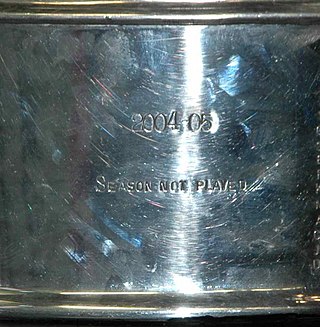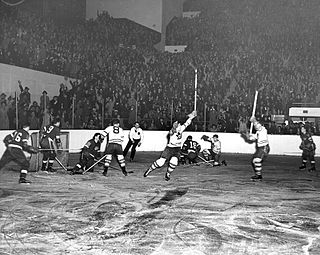
The National Hockey League is a professional ice hockey league in North America composed of 32 teams – 25 in the United States and 7 in Canada. The NHL is one of the major professional sports leagues in the United States and Canada and is considered the premier professional ice hockey league in the world, with players from 17 countries as of the 2023–24 season. The Stanley Cup, the oldest professional sports trophy in North America, is awarded annually to the league playoff champion at the end of each season. The International Ice Hockey Federation (IIHF) views the Stanley Cup as one of the "most important championships available to the sport". The NHL is headquartered in Midtown Manhattan.

Gary Bruce Bettman is an American sports executive who serves as the commissioner of the National Hockey League (NHL), a post he has held since February 1, 1993. Previously, Bettman was a senior vice president and general counsel to the National Basketball Association (NBA). Bettman is a graduate of Cornell University and New York University School of Law. Bettman was elected to the Hockey Hall of Fame in 2018.

The National Hockey League Players' Association is the labour union for the group of professional hockey players who are under Standard Player Contracts to the 32 member clubs in the National Hockey League (NHL) located in the United States and Canada. The association represents its membership in all matters dealing with their working conditions and contractual rights as well as serving as their exclusive collective bargaining agent.

The National Hockey League commissioner is the highest-ranking executive officer in the National Hockey League (NHL). The position was created in 1993; Gary Bettman was named the first commissioner and remains the only person to fill the position to date. Among other duties, the commissioner leads collective bargaining negotiations on behalf of the league and appoints officials for all NHL games.
Gilbert Stein was an American lawyer, law instructor, and professional ice hockey executive. Stein served with the National Hockey League (NHL) as vice president and legal counsel for nearly 15 years before serving as the fifth and last president of the NHL from 1992 to 1993.

The 2004–05 NHL season would have been the National Hockey League's 88th season of play. The entire 1,230-game schedule, that was set to begin in October, was officially canceled on February 16, 2005, due to an unresolved lockout that began on September 16, 2004. The loss of the 2004–05 season's games made the NHL the second North American professional sports league to lose an entire postseason of games because of a labor dispute, the first being the 1994–95 MLB strike, which occurred 10 years prior. It was the first time since 1919, when the Spanish flu pandemic canceled the finals, that the Stanley Cup was not awarded. This canceled season was later acknowledged with the words "2004–05 Season Not Played" engraved on the Cup.
The 2004–05 NHL lockout was a labor lockout that resulted in the cancellation of the National Hockey League (NHL) season, which would have been its 88th season of play.

The 1992–93 NHL season was the 76th regular season of the National Hockey League. Each player wore a patch on their jersey throughout the season to commemorate the 100th anniversary of the Stanley Cup. The league expanded to 24 teams with the addition of the Ottawa Senators and the Tampa Bay Lightning. Under the new labour agreement signed following the 1992 NHL strike, each team began playing 84 games per season, including two games at neutral sites.
Robert W. "Bob" Goodenow is an American lawyer who served as the second executive director of the NHL Players Association from 1992 until his resignation on July 28, 2005.
Robert Alan Eagleson is a disbarred Canadian lawyer, hockey agent and promoter. Clients that he represented included superstars Bobby Orr and Darryl Sittler. He was the first executive director of the NHL Players Association (NHLPA), which was initially lauded for improving the bargaining power of National Hockey League (NHL) players. He is also well known for providing the opportunity for professional players to compete in international hockey, by promoting the 1972 Summit Series between Canada and the Soviet Union, and the Canada Cup. However, Eagleson was convicted of fraud and embezzlement and briefly imprisoned, after it was revealed that he had abused his position for many years by defrauding his clients and skimming money from tournaments. After his convictions, he was removed as a member of the Order of Canada and resigned from the Hockey Hall of Fame where he had been inducted in the builder category.

Ice hockey tournaments have been staged at the Olympic Games since 1920. The men's tournament was introduced at the 1920 Summer Olympics and was transferred permanently to the Winter Olympic Games program in 1924, in France. The women's tournament was first held at the 1998 Winter Olympics.
The 1994–95 NHL season was the 78th regular season of the National Hockey League. The season start was delayed due to a lockout of players imposed by the NHL franchise owners. After a new labour agreement was reached between the owners and the National Hockey League Players' Association (NHLPA), a 48-game season started on January 20. The season ended when the New Jersey Devils swept the heavily favored Detroit Red Wings for their first Stanley Cup win. It was also their first appearance in the finals overall.

The 1991–92 NHL season was the 75th regular season of the National Hockey League. The league expanded to 22 teams with the addition of the expansion San Jose Sharks. A ten-day players' strike was called in April, delaying the final weeks of the regular season and the playoffs, and pushing the Stanley Cup Finals into June for the first time. The Pittsburgh Penguins repeated as Stanley Cup champions, winning the best of seven series four games to none against the Chicago Blackhawks.
The 1994–95 NHL lockout was a lockout that came after a year of National Hockey League (NHL) hockey that was played without a collective bargaining agreement. The lockout was a subject of dispute as the players sought collective bargaining and owners sought to help franchises that had a weaker market as well as make sure they could cap the rising salaries of players. The lockout caused the 1994–95 season to be delayed and shortened to 48 games instead of 84 or 82, the shortest season in 53 years.
Ted Saskin served as the third executive director of the NHL Players Association from 2005 to 2007. He assumed the title after Bob Goodenow resigned on July 28, 2005, but was unanimously fired by the NHLPA on May 10, 2007, after a union-commissioned report concluded Saskin had quarterbacked a campaign to hack into player email accounts.

The history of the National Hockey League begins with the end of its predecessor league, the National Hockey Association (NHA), in 1917. After unsuccessfully attempting to resolve disputes with Eddie Livingstone, owner of the Toronto Blueshirts, executives of the three other NHA franchises suspended the NHA, and formed the National Hockey League (NHL), replacing the Livingstone team with a temporary team in Toronto, the Arenas. The NHL's first quarter-century saw the league compete against two rival major leagues—the Pacific Coast Hockey Association and Western Canada Hockey League—for players and the Stanley Cup. The NHL first expanded into the United States in 1924 with the founding of the Boston Bruins, and by 1926 consisted of ten teams in Ontario, Quebec, the Great Lakes region, and the Northeastern United States. At the same time, the NHL emerged as the only major league and the sole competitor for the Stanley Cup; in 1947, the NHL completed a deal with the Stanley Cup trustees to gain full control of the Cup. The NHL's footprint spread across Canada as Foster Hewitt's radio broadcasts were heard coast-to-coast starting in 1933.
John Augustus Ziegler Jr. was an American lawyer and ice hockey executive. Upon succeeding Clarence Campbell in 1977, he became the fourth president of the National Hockey League. Ziegler served as league president through 1992. His 15-year term was marked by the 1979 merger that integrated four teams from the rival World Hockey Association into the NHL, and by increasing labor unrest among the players. The first American to serve as chief executive of the NHL, he received the Lester Patrick Trophy in 1984 and was inducted into the Hockey Hall of Fame in 1987.

The Original Six era of the National Hockey League (NHL) began in 1942 with the demise of the Brooklyn Americans, reducing the league to six teams: Boston Bruins, Chicago Black Hawks, Detroit Red Wings, Montreal Canadiens, New York Rangers, and Toronto Maple Leafs. This structure remained stable for a quarter century; the era ended in 1967 when the NHL doubled in size adding six expansion teams.

The expansion era of the National Hockey League (NHL) began when six new teams were added for the 1967–68 season, ending the Original Six era. The six existing teams were grouped into the newly created East Division, and the expansion teams—the Los Angeles Kings, Minnesota North Stars, Oakland Seals, Philadelphia Flyers, Pittsburgh Penguins and St. Louis Blues—formed the West Division.

The National Hockey League (NHL) endured a tumultuous period of history between 1992 and 2017. It grew from 22 teams at the start of this period to 30 at the end, as the league expanded across the United States. Repeated labour conflicts interrupted play in 1992, 1994–95, 2004–05 and 2012–13; the second lockout caused the entire 2004–05 NHL season to be canceled, the first time in North American history that a sports league has canceled an entire season in a labour dispute. Nine franchises were added between 1991 and 2000, comprising the San Jose Sharks, Ottawa Senators, Tampa Bay Lightning, Florida Panthers, Mighty Ducks of Anaheim, Nashville Predators, Atlanta Thrashers, Columbus Blue Jackets and the Minnesota Wild. In addition to expansion teams, five franchises have relocated during this time: the Minnesota North Stars became the Dallas Stars (1993), the Quebec Nordiques became the Colorado Avalanche (1995), the Winnipeg Jets became the Phoenix Coyotes (1996), the Hartford Whalers became the Carolina Hurricanes (1997), and the Atlanta Thrashers became the second franchise known as the Winnipeg Jets (2011). In 1999, Wayne Gretzky retired from hockey.










